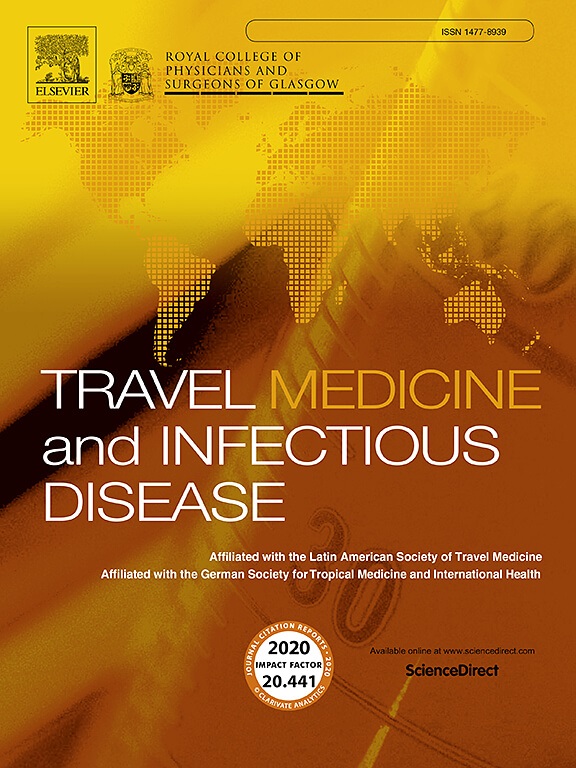Mapping the global risk of chikungunya virus endemicity and autochthonous transmission following importation
IF 4.7
3区 医学
Q1 INFECTIOUS DISEASES
引用次数: 0
Abstract
Background
Chikungunya virus, emerging as an increasingly significant global health threat, poses significant uncertainty regarding the global risk of its endemicity and autochthonous transmission following importation.
Methods
In this study, we established a multi-source database spanning 70 years (1953–2023), synthesizing 4515 geolocated records of human, vector, and animal infections alongside clinical metadata. Three machine learning algorithms were utilized to analyze the ecological factors associated with CHIKV occurrences in regions characterized by endemic or autochthonous transmission following importation. Subsequently, the respective risk distributions of CHIKV occurrences were projected and used the SHAP method to rank feature importance and interpret model predictions.
Results
Machine learning frameworks that stratifying endemic zones and importation-transmission prone regions have revealed consistent ecological drivers, albeit with significantly discrepant rankings of feature importance. The habitat suitability indices of Aedes aegypti and Aedes albopictus, as indicated by the Shapley values analysis, were identified as the most significant contributing factors for endemic occurrence and autochthonous transmission following importation, respectively. Population density, human footprint index, precipitation, thermal conditions, and the habitat suitability indices of other mosquito vectors also play crucial roles in the transmission within the two regions. Notably, temperate regions with established Ae. albopictus populations, including southern United States, most parts of Western Europe, East Asia, West Asia and Australia, emerged as high-risk hotspots for autochthonous transmission following importation.
Conclusions
This study assesses the potential risks of endemic occurrence and post-import autochthonous transmission of CHIKV, respectively. The frameworks provide insights for informing vaccine deployment strategies and mitigating globalization-driven arboviral threats.
绘制输入后基孔肯雅病毒流行和本地传播的全球风险图
基孔肯雅病毒作为日益严重的全球健康威胁出现,对其地方性和输入后本地传播的全球风险构成了重大不确定性。方法在本研究中,我们建立了一个跨越70年(1953-2023)的多源数据库,综合了4515份人类、媒介和动物感染的地理记录以及临床元数据。利用三种机器学习算法分析了在以输入后流行或本地传播为特征的地区与CHIKV发生相关的生态因素。随后,分别预测了CHIKV发生的风险分布,并使用SHAP方法对特征重要性进行排序并解释模型预测。结果:对流行区和输入性传播易发地区进行分层的机器学习框架揭示了一致的生态驱动因素,尽管特征重要性排名存在显著差异。Shapley值分析表明,埃及伊蚊和白纹伊蚊的生境适宜性指数分别是导致当地流行和输入后本地传播的最重要因素。人口密度、人类足迹指数、降水、热条件和其他媒介蚊媒生境适宜性指数也在两区传播中发挥重要作用。值得注意的是,温带地区已建立伊蚊。白纹伊蚊种群,包括美国南部、西欧大部分地区、东亚、西亚和澳大利亚,在输入后成为本地传播的高风险热点。结论本研究分别评估了寨卡病毒流行和输入后本地传播的潜在风险。这些框架为通报疫苗部署战略和减轻全球化驱动的虫媒病毒威胁提供了见解。
本文章由计算机程序翻译,如有差异,请以英文原文为准。
求助全文
约1分钟内获得全文
求助全文
来源期刊

Travel Medicine and Infectious Disease
PUBLIC, ENVIRONMENTAL & OCCUPATIONAL HEALTH-INFECTIOUS DISEASES
CiteScore
19.40
自引率
1.70%
发文量
211
审稿时长
49 days
期刊介绍:
Travel Medicine and Infectious Disease
Publication Scope:
Publishes original papers, reviews, and consensus papers
Primary theme: infectious disease in the context of travel medicine
Focus Areas:
Epidemiology and surveillance of travel-related illness
Prevention and treatment of travel-associated infections
Malaria prevention and treatment
Travellers' diarrhoea
Infections associated with mass gatherings
Migration-related infections
Vaccines and vaccine-preventable disease
Global policy/regulations for disease prevention and control
Practical clinical issues for travel and tropical medicine practitioners
Coverage:
Addresses areas of controversy and debate in travel medicine
Aims to inform guidelines and policy pertinent to travel medicine and the prevention of infectious disease
Publication Features:
Offers a fast peer-review process
Provides early online publication of accepted manuscripts
Aims to publish cutting-edge papers
 求助内容:
求助内容: 应助结果提醒方式:
应助结果提醒方式:


